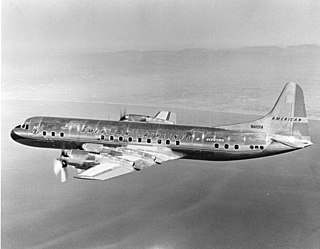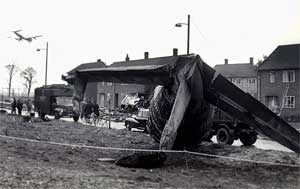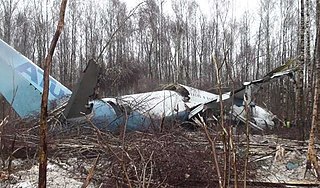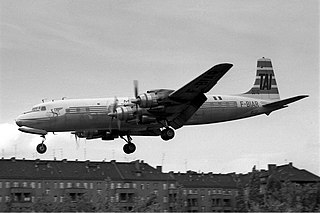This is a list of aviation-related events from 1960.

American Airlines Flight 320 was a scheduled flight between Chicago Midway Airport and New York City's LaGuardia Airport. On February 3, 1959, the Lockheed L-188 Electra performing the flight crashed into the East River during its descent and approach to LaGuardia Airport, killing 65 of the 73 people on board. Weather conditions in the area were poor, and the aircraft descended through dense clouds and fog. As it approached the runway, it flew lower than the intended path and crashed into the icy river 4,900 feet (1,500 m) short of the runway. American Airlines had been flying the newly-developed Lockheed Electra in commercial service for only about two weeks before the crash, and the accident was the first involving the aircraft type.
Austrian Airlines AG, often shortened to Austrian or AUA, is the flag carrier of Austria and a subsidiary of Lufthansa, the flag carrier of the Federal Republic of Germany. The airline is headquartered on the grounds of Vienna International Airport in Schwechat where it also maintains its hub. As of July 2016, the airline flew to six domestic and more than 120 international year-round and seasonal destinations in 55 countries and is a member of the Star Alliance.

United Air Lines Flight 297 was a scheduled flight from Newark International Airport to Atlanta that crashed 10 miles (16 km) southwest of Baltimore on November 23, 1962, killing all 17 people on board. An investigation concluded that the aircraft, a Vickers Viscount 745D turboprop airliner, had struck at least two whistling swans, which caused severe damage to the plane, resulting in a loss of control.

TWA Flight 128 was a regularly scheduled Trans World Airlines passenger flight from Los Angeles to Boston, with intermediate stops in Cincinnati and Pittsburgh. On November 20, 1967, Flight 128 crashed on final approach to Greater Cincinnati Airport; 70 of the 82 people aboard the Convair 880 were killed in the tragic crash.

Mohawk Airlines Flight 411, a Fairchild FH-227B twin-engine turboprop, registered N7811M, was a scheduled domestic passenger service operated by Mohawk Airlines, between Albany and Glens Falls, New York. On November 19, 1969, it crashed into Pilot Knob Mountain, killing all 14 passengers and crew on board.
Flight 901 is an airline flight number that has had multiple accidents and incidents over the years. As so, the designation may refer to:

Turkish Airlines Flight 1951 was a passenger flight that crashed during landing at Amsterdam Schiphol Airport, the Netherlands, on 25 February 2009, resulting in the deaths of nine passengers and crew, including all three pilots.

Japan Air Lines Flight 446 was a Japan Air Lines flight from Sheremetyevo International Airport of Moscow, Russian SFSR, Soviet Union to Tokyo International Airport in Ōta, Tokyo, Japan.

British European Airways Flight 411 crashed on approach to Manchester Airport after a flight from Amsterdam Schiphol International Airport on 14 March 1957 and hit a house in Wythenshawe. All on board, 20 passengers and crew, died in the crash as did two people in the house. The aircraft involved was a Vickers Viscount registration G-ALWE operated by British European Airways. The cause of the crash was metal fatigue in flaps causing loss of control.

Aviastar-TU Flight 1906 was a Tupolev Tu-204 that crashed while attempting to land at Domodedovo International Airport, Moscow, Russia, in heavy fog on 22 March 2010. The aircraft was on a ferry flight from Hurghada International Airport, Egypt to Moscow, and had no passengers on board; all eight crew survived the accident, four with serious injuries requiring hospitalization and four with minor injuries. The accident was the first hull loss of a Tu-204 and the first hull loss for Aviastar-TU.

The 1957 Nutts Corner BEA Viscount crash was a British European Airways (BEA) flight from London to Belfast that crashed at Nutts Corner Airport on 23 October 1957, killing all seven passengers and crew.

On the evening of 30 November 1961, Ansett-ANA Flight 325, a service from Sydney to Canberra, Australia, operated by a Vickers Viscount 720, broke up in mid-air and crashed shortly after takeoff, when it encountered a severe thunderstorm. All 15 people on board were killed.

On 5 January 1953, a Vickers Viking airliner operated by British European Airways crashed on approach to Belfast Nutts Corner Airport, Northern Ireland. The aircraft was on a domestic flight from London Northolt Airport with 31 passengers and 4 crew on board. Twenty-four of the passengers and three crew members died in the accident.

Lufthansa Flight 502 was a scheduled flight from Hamburg, Germany to Buenos Aires, Argentina on 11 January 1959. The flight was being operated by a Lockheed L-1049G Super Constellation. On the leg between Senegal and Brazil the Super Constellation was on approach to Rio de Janeiro–Galeão International Airport when it crashed near Flecheiras Beach just short of the runway. All 29 passengers and seven of the ten crew were killed. It was the first fatal accident involving the current Lufthansa since it was formed in 1955.

TAI Flight 307 was a scheduled flight operated by Transports Aériens Intercontinentaux (TAI) between France and the Ivory Coast via Mali operated by a Douglas DC-7C. On 24 September 1959, the aircraft crashed during its departure from Bordeaux–Mérignac Airport, France when it flew into trees. All of the flight crew and 45 of the 56 passengers on board were killed; the other 11 passengers were seriously injured.

Aeropesca Colombia Flight 221 was an internal scheduled passenger flight from Florencia Airport to Neiva Airport in Colombia. On 26 August 1981 it was being operated by a Vickers Viscount turboprop airliner registered in Colombia as HK-1320 when it collided with Mount Santa Elana, an Andean mountain peak, destroying the aircraft and killing all 50 on board.

Aeroflot Flight 065 was a scheduled passenger flight operated by the International Civil Aviation Directorate division of Aeroflot. On 17 February 1966 at 1:38 am local time a Tupolev Tu-114 crashed during take-off from Sheremetyevo International Airport in Moscow, killing 21 of the 47 passengers and 19 crew members on board. This was the only fatal incident involving a Tu-114. A committee investigating the accident found that the crash was due to multiple crew and ATC failures.















